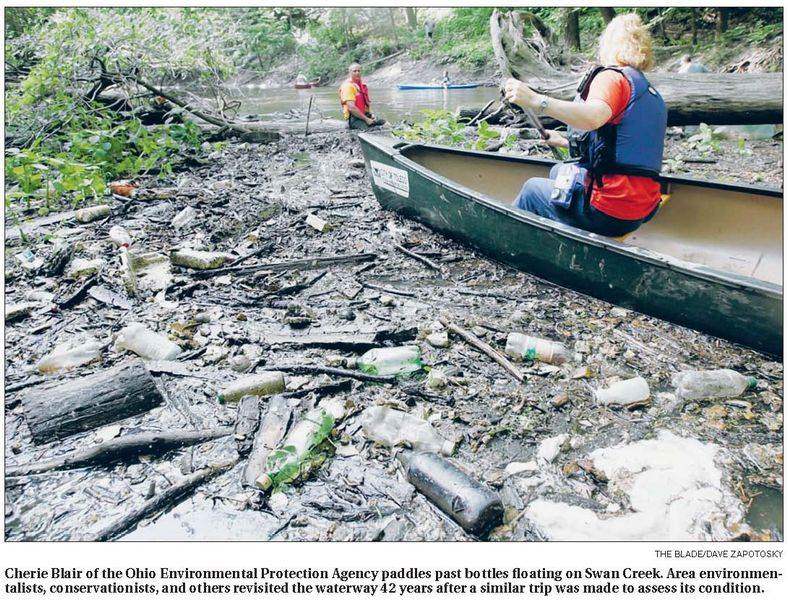
Swan Creek at times more ugly duckling
6/7/2008

Jim Bennett is a perceptive man.
In 1966, he was one of three men who canoed the 10-plus miles of Swan Creek that flow through the city of Toledo.
Yesterday, he made a return trip with Partners for Clean Streams Inc., a nonprofit that recently merged with the Maumee Remedial Action Plan. The latter is a group created two decades ago to unite the region on cleanup efforts for Toledo-area waterways.
Many had been identified as hot spots of pollution by the International Joint Commission, an agency that has helped the United States and Canada address boundary-water issues for nearly a century.
Mr. Bennett's assessment of what he saw after paddling from Reynolds Road in South Toledo to the Erie Street Market in downtown was summed up in two sets of seemingly contradictory statements:
"It was a wonderful trip. There is more wildlife."
"We haven't done much. It's a shame."
A longtime conservationist and president of Toledo Caisson, Mr. Bennett was accompanied by a Blade writer-photographer team, reporter Hank Harvey and photographer Jack Ackerman, to assess the state of Swan Creek 42 years ago this month.

A 1966 Blade headline summed up their trip as follows:
"Swan Creek Now a Floating Dump, Poisoned by Oil, Trash, Sewage."
Progress since then has been painfully slow, Mr. Bennett said.
"I'd like to see the water quality at the mouth of Swan Creek as it is at Reynolds Road. It hasn't improved a lot," he said, including references to human waste that has been pushed into the creek by excessive stormwater.
The late Ned Skeldon, founder of Clear Water, a seminal environmental group that disbanded last year following the PCS-Maumee RAP merger, helped organize the 1966 field trip along Swan Creek.
Mr. Skeldon's group, in fact, targeted the creek for its first cleanup effort. Clear Water was created with The Blade's support before the modern environmental movement began following the first Earth Day in 1970.
By 1968, a cleanup barge finally was lowered into the creek. Appliances, car bodies, and assorted trash were removed, clearing out many flow-impeding logjams.
But pollution issues remained because of the city's antiquated sewer system that allowed for the untreated waste to enter the waterways whenever there was heavy rain.
Fast-forward to 2008. The city is still addressing those overflows.
City Councilman Frank Szollosi yesterday paddled his kayak alongside Mr. Bennett's canoe, which was flanked by a small flotilla of canoes filled with area environmentalists, conservationists, and agency representatives. The councilman came to the same diametrically opposed conclusions as Mr. Bennett:
Swan Creek, from a canoe, appears beautiful and full of wildlife. But the water quality leaves much to be desired.
Mr. Szollosi said the trip "really highlights the importance of the city's consent decree with the U.S. EPA," referring to a 2002 federal court agreement.
Out of the agreement came the Toledo Waterways Initiative, a historic $450 million expansion and improvement of the city's sewage network intended to eliminate overflows by 2015 - nearly 50 years after Mr. Skeldon and others raised a stink about the creek. The agreement was signed by then-Mayor Jack Ford after 16 years of negotiations with the federal agency.
Swan Creek "is an underappreciated jewel in our city," Mr. Szollosi said.
"Other cities out West would kill to have it. We need to do more to clean it, promote it for recreation. We need to get more kids on it," he said.
All manner of wildlife were seen during the day, from white-tailed deer, fox squirrels, and woodchucks to turtles, great blue herons, and mallard and wood ducks and their families of ducklings. There also were such colorful songbirds as a Baltimore oriole and barn swallows, the latter of which swooped around their mud nests beneath virtually every bridge.
Though the heat warnings were out, the green canopy - topped by magnificent, thick, towering cottonwoods - cooled air for the paddlers and tamed the beating solar rays. In places fluffy cottonwood seeds so carpeted the flood plain of the Swan that it seemed drifted with skiffs of light snow.
The natural cooling was welcome, given the 12 to 14 impossibly impassable logjams that had to negotiated - sometimes by grunting, muddy, sweaty, slippery portages and sometimes by chainsaw. Obviously, it has been a while since organized crews have swept downstream.
But it has not been 42 years. In 1990, activist Betty Mauk whipped up a similar canoe trip.
Back then, 164 tons of trash were removed - including 82 grocery carts between Highland Park and the Maumee River.
Yesterday only two bicycles and 15 or so of the wire carts could be found. Three of the latter were nearly buried in silt below Byrne Road.
And there was less odor, at least compared to what was experienced by Mr. Bennett's crew in 1966 and Mrs. Mauk's contingent in 1990. Each sewage outfall passed, however, provided a blast of supercooled subterranean air, with a hint of that sewer smell.
A 1990 account in The Blade spoke of the same dichotomy of surface beauty above the water and filth in the water. And it spoke of completing that self-same interceptor sewer project "on time by 1996."
Although few fish other than carp were seen yesterday, the Swan now is known for its largemouth bass, bluegills, and other panfish, and a fine spring run of white bass.
Fish populations should receive a boost with a forthcoming project to remediate the impact of Highland Park Dam. Three stepped "lifts" of the stream bed just downstream will be created to improve fish movement upstream with a ladderlike effect.
Contact Steve Pollick at:
spollick@theblade.com
or 419-724-6068.